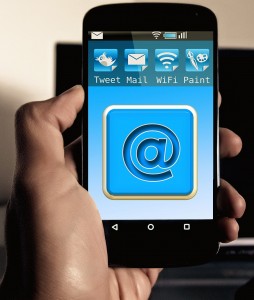 E-mail is a very popular form of communication these days. There are some definite benefits. When you call someone on the phone you may be interrupting them. Most often, they will answer the phone to silence the ringing whether it is a good time for them to talk or not. Etiquette says that you shouldn't just jump in and get to the point. It's polite to make small talk first, "Hi, How are you?" "Fine, thanks. How are you?" You can go back and forth like this for several minutes before ever arriving at the reason for your call. By the time you discuss what you wanted to you may have been on the phone for fifteen minutes or more. Add to that the fact that you may catch the other party off guard by asking them a question they weren't prepared to answer. Without time to gather their thoughts they may give an incorrect response. In contrast, e-mail is less invasive and allows the recipient time to formulate a response before they reply. You send the message at your convenience, they respond at theirs. No worrying about social conventions such as not calling too early or too late, you can e-mail anytime of the day or night since they will just check it the next time they are available. Sounds great, right? No wonder e-mail is so popular. There are some real issues with e-mail though. Keep reading for some tips on how to use e-mail effectively within your small business and avoid some of the pitfalls. We'll also tell you how Stockpile small business inventory solution can help.
E-mail is a very popular form of communication these days. There are some definite benefits. When you call someone on the phone you may be interrupting them. Most often, they will answer the phone to silence the ringing whether it is a good time for them to talk or not. Etiquette says that you shouldn't just jump in and get to the point. It's polite to make small talk first, "Hi, How are you?" "Fine, thanks. How are you?" You can go back and forth like this for several minutes before ever arriving at the reason for your call. By the time you discuss what you wanted to you may have been on the phone for fifteen minutes or more. Add to that the fact that you may catch the other party off guard by asking them a question they weren't prepared to answer. Without time to gather their thoughts they may give an incorrect response. In contrast, e-mail is less invasive and allows the recipient time to formulate a response before they reply. You send the message at your convenience, they respond at theirs. No worrying about social conventions such as not calling too early or too late, you can e-mail anytime of the day or night since they will just check it the next time they are available. Sounds great, right? No wonder e-mail is so popular. There are some real issues with e-mail though. Keep reading for some tips on how to use e-mail effectively within your small business and avoid some of the pitfalls. We'll also tell you how Stockpile small business inventory solution can help.
- Tone. When you speak to someone in person or over the phone you can usually gauge their mood. You can tell if they are agreeable to what you're discussing, annoyed, excited, etc. There are verbal and non-verbal cues that convey their mood. E-mail is lacking those clues. It is simply lines of text. You can't tell whether the writer was smiling when they typed their message or not. Emoticons can be used in personal e-mails to indicate mood but they don't fit well in professional messages. Only use emoticons when corresponding with employees, or clients that you know very well. So, what can you do to convey your mood when writing an e-mail? Many people use all caps to "shout" at someone when they're angry. This can be offensive and still not all that effective. We recommend choosing your words carefully. Take for instance the following two examples:
- We are behind on our orders so everyone will need to work late tonight.
- Everyone has been working really hard, but we are still behind on our orders. I'd like everyone to work late tonight so that we can get caught up.
Both convey the message that employees need to stay late. The first one is short and to the point and could be read as terse and uncaring. The second one, on the other hand, acknowledges everything your employees have been doing and asks them for their continued support and extra effort. Which one do you think would go over better with your employees?
2. Reply to all. E-mail is a convenience. It makes it easier to communicate with your employees, associates and customers. It should not, however, be abused. Yes, you can blast messages to numerous people at once, but don't do it just because you can. Keep in mind that if you start a thread to a number of people, and they all use the reply to all option when they respond, your inbox could quickly be overflowing. When you start getting replies from multiple people the thread can become confusing and hard to follow. Was that reply in response to your original message or to something that someone else said in reply? It can be very hard to follow. Only reply to all if there is value in sharing your response with everyone. For example, when organizing lunch plans it can be helpful for everyone's replies to go to everyone else. Now there isn't just one person trying to find a day and time that works for everyone. In other cases, having one point person who them disseminates the information to the others would be more beneficial.
3. Check your recipients carefully. When you place a phone call you can determine that you're talking to the correct party, with e-mail your message is already there, whether it has reached the intended recipient or not. Thanks to autofill, few of us type full e-mail addresses when sending messages. All you need are the first few letters for someone in your contact list and then you can just highlight the name that you want. Choose carefully. It's likely that you have numerous contacts with similar names or e-mail addresses. In most cases it just makes you look careless if you send a message to the wrong person. There are times when a misdirected message could be detrimental to your business. You don't want to share trade secrets with your competitors, provide customers with confidential information and so much more. Always check and double check to be sure that your message is headed in the right direction.
4. Patience. E-mail is not instantaneous. You know when you sent your message, you don't know when they received it. Often we expect a speedy reply. When we don't get it we can start to speculate as to why the recipient hasn't responded, often overlooking the obvious, they just haven't checked their messages yet. Be patient when awaiting a response. There is nothing worse than following up with repeated messages badgering someone who hasn't even seen your first message. If your query is that time sensitive, perhaps a phone call would be a better method of communication.
5. Potential for forwarding. Anything you say in e-mail is in writing. Your recipient now has a record of what was said. Don't type anything in an e-mail that you wouldn't want forwarded to others. There is always the potential that your recipient will choose to share what you've written with others. To avoid potential embarrassment be careful what you write.
E-mail is a very effective form of communication, when used correctly. For more small business tips, check back with our blog soon.
Choose the Small Business Inventory Solution Designed for You
If you've got inventory, you need Stockpile small business inventory solution. Stockpile is the fast and easy way to track your inventory. Designed for small businesses, Stockpile puts amazing power at your fingertips. Stockpile is fully customizable so you can add the fields that you want to your item records. Plus, you can include photographs for easy identification. Stockpile small business inventory solution is also mobile compatible, allowing you to access your data anytime from anywhere. Running reports is also a snap. Why struggle with inventory issues? Stockpile small business inventory solution makes inventory management easy. Try Stockpile today!





